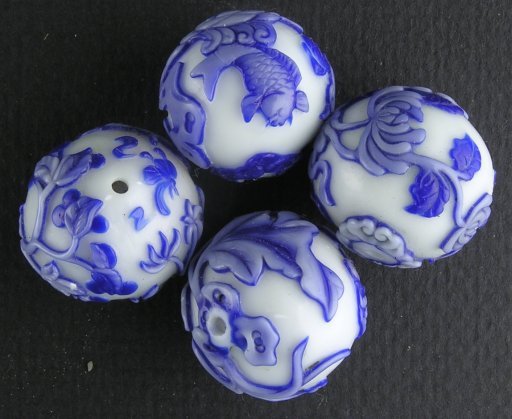This is the third post in my series about some chinese lampwork for which I traded. These are currently my favorites, though obviously the red and blue ones originally caught my attention, as I have the most of those. You would assume, looking at these inch-diameter beads, that they would be horrendously heavy, but you would be wrong: they're hollow.
However, it's my theory that they're made using a technique different the mandrel winding one I typically use, or even the blown-tubing method that is probably what typically comes to mind. I think these are core-made beads. This is how the romans originally made their beautifully feathered vessels centuries ago, and in fact the Japanese core vessel I saw demoed was also feathered (that is, striped and the stripes raked crosswise—people do this for marbled paper and cake icing, so it's not as exotic as it might sound).
This technique is also used by western lampworkers, but usually to make vessels, not beads. In the modern version you tightly wind strips of four-ought (0000) steel wool around your mandrel, then dip the whole mess in bead release. For really large vessels, you might slick the steel wool down with release in layers. Then you (in effect) case the volume of wool and release on your mandrel to make your vessel shape.
Then, of course, there's the fun of removing the steel wool and bead release afterwards, and it's a chore. I'm not certain how (or even if) all the contents were from these chinese beads, but I think that's how the base beads were made. Certainly this approach would allow for nice even wall thicknesses, and also to keep the sizes consistant. So why doesn't everyone do this technique?
Right. It's incredibly time-consuming. Unless you're doing a fancy vessel or carved bead, it's not worth it.
file created 13oct06
Unless otherwise noted, text, image and objects depicted therein copyright 1996--present sylvus tarn.
Sylvus Tarn